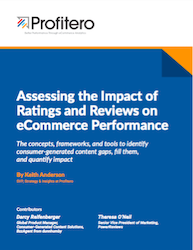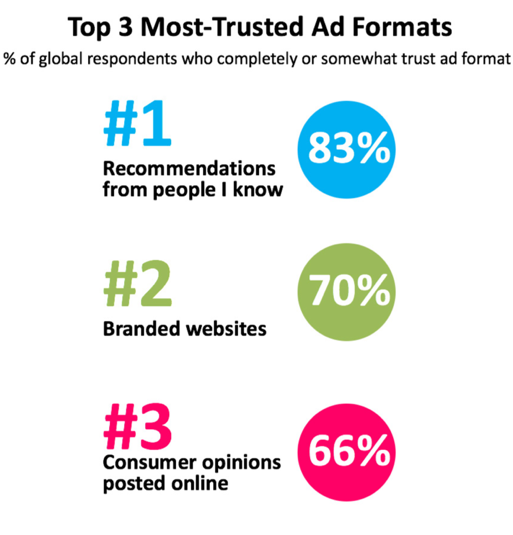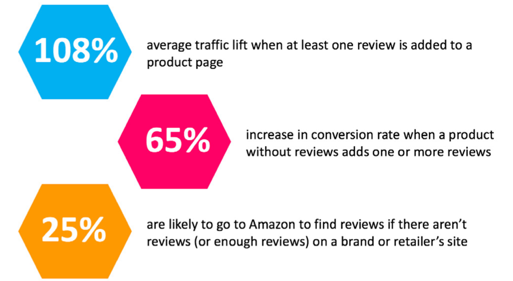

Having best-in-class consumer-generated ratings and reviews content is more important than ever. It’s become an expected and influential part of the purchase journey. Consequently, it’s also become an important part of brand and retailer marketing strategies.
PowerReviews research finds that 95% of shoppers consult ratings and reviews while they’re shopping. And 86% consider reviews an essential resource when making a purchase decision. Ratings and reviews rank high among the top factors impacting purchasing decisions, coming in at #2, just behind price.
The reason: Consumers trust them. Consumer opinions posted online consistently ranks among the top three sources of information, according to Nielsen’s Global Trust in Advertising Survey. The study shows that two-thirds (66%) of global respondents trust consumer opinions posted online.

Source: Nielsen Global Trust in Advertising Survey, 2015
There are several reasons every brand and retailer should not only have a ratings and reviews content plan, but also continually monitor and take action on the associated analytics. Ratings and reviews are a key tool for brands and retailers looking to drive traffic and sales, online as well as offline. They can be a good source of insights too.
Online benefits
There’s much to be said for having lots of reviews, specifically positive reviews. They help drive traffic to your products with typically better conversion on that traffic, ultimately driving sales.
Leading ratings, reviews, and question and answer technology provider PowerReviews’ SVP of Marketing Theresa O’Neil shared some company research. “We found that when at least one review is added to a product page, that product receives an average 108% traffic lift. And when a product without reviews adds one or more reviews, the conversion rate for that product increases by 65%.”
What’s more, brands and retailers that don’t feature ratings and reviews on their site risk losing shoppers to a site that does. According to PowerReviews research on the path to purchase, nearly half of shoppers will turn to a search engine if there aren’t reviews (or aren’t enough reviews) for a product on a brand or retailer site. Twenty-five percent are likely to head to Amazon to find reviews, and 20% will leave for another brand or retailer site.
Offline Benefits
Because we know that so many people search for and research products online that they ultimately buy offline, there’s a related phenomenon that has been dubbed ROBO by one review syndicator – research online, buy offline – which is based heavily on reviews.
Even if people don’t ultimately buy on Amazon or another online retailer, they’re in-aisle checking reviews on Amazon while in the store. So having product reviews has a potentially even greater impact on brand perception and offline sales, especially as more shoppers walk through the aisles with their smartphones. According to Deloitte, digital interactions now influence 56 cents of every dollar spent in brick-and- mortar stores.
Source of Insights
Ratings and reviews can also be an interesting source of shopper and consumer insights, at times providing a wealth of information that can help retailers and brands better serve their customers.
O’Neil shared an example of how Hammacher Schlemmer, a PowerReviews customer, noticed that a watch they sold on their website had an average star rating of 2.7. After digging into the reviews for the watch, the company noticed that several customers mentioned the clasp on the watch wasn’t working. Hammacher Schlemmer took this information to their manufacturer to change the clasp, and the average star rating for the watch climbed to 4.7.
So indeed, it’s beneficial to brands and retailers alike to mine reviews from verified purchasers to not only learn what people like or don’t like about a product, but also what people did or didn’t enjoy about buying it, i.e., the shopping and shipping process. And this is an important distinction – parsing comments about the product itself versus the buying process.
For example, there may be reviews about the delivery speed, damaged packaging, late arrival or a wrong product shipped. So it’s important for brands to discern that these kinds of negative reviews are not actually about the product, they’re about the retailer. Still, a retailer’s poor service level can certainly drag down a brand’s average star rating.
Impact of Ratings and Reviews on eCommerce Performance

Source: PowerReviews Research
For more guidance on the importance of formulating a Ratings and Reviews strategy, download Profitero’s new white paper: Assessing the Impact of Ratings and Reviews on eCommerce Performance.


























